Peanut: How to Introduce Your Baby to this Potentially Allergenic Food
- Whether or not your baby is at high risk for peanut allergy
- When to start offering peanut protein and how often to reintroduce
- 3 easy ways to make peanuts safe for your baby to eat once they start solid foods
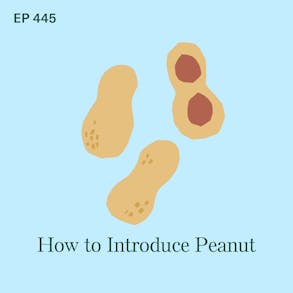
LISTEN TO THIS EPISODE
Episode Description
How do you know if your baby is allergic to peanuts? The only way to know is to offer your baby peanut. In this episode I’m sharing 3 easy ways to safely offer your baby peanut with tips on how to reintroduce peanut early and often to help lower the risk of peanut allergy.

Links from this Episode
- Puffworks Baby Peanut Butter Puffs use affiliate code BLWPOD for 15% off at checkout, shop here: https://puffworks.com/discount/BABYLED?redirect=/pages/baby-led
- Baby-Led Weaning with Katie Ferraro program with the 100 First Foods™ Daily Meal Plan, join here: https://babyledweaning.co/program
- Baby-Led Weaning for Beginners free online workshop with 100 First Foods™ list to all attendees, register here: https://babyledweaning.co/baby-led-weaning-for-beginners
Other Episode Related to this Topic
- Episode 136 - Peanut Butter Puffs for Safely Introducing Peanuts to Babies: A Conversation with @puffworks Founder Greg Murphy
- Episode 274 - Baby Has Skin Reactions to Milk, Egg and Peanut: What Should I Do Next? with Carina Venter, PhD, RDN
- Episode 366 - Oral Immunotherapy: Helping Babies Become Less Reactive to Allergenic Foods with David Stukus, MD
- Episode 380 - Why Doctors STILL Aren't Talking About Introducing Allergenic Foods with Ruchi Gupta, MD, MPH
Resources & Research
- Abrams, Elissa M et al. “Pros and cons of pre-emptive screening programmes before peanut introduction in infancy.” The Lancet. Child & adolescent health vol. 4,7 (2020): 526-535.
- Du Toit, George et al. “Randomized trial of peanut consumption in infants at risk for peanut allergy.” The New England journal of medicine vol. 372,9 (2015): 803-13.
- Du Toit, George et al. “Effect of Avoidance on Peanut Allergy after Early Peanut Consumption.” The New England journal of medicine vol. 374,15 (2016): 1435-43.
- Peters, Rachel L et al. “Natural history of peanut allergy and predictors of resolution in the first 4 years of life: A population-based assessment.” The Journal of allergy and clinical immunology vol. 135,5 (2015): 1257-66.e1-2.

Latest Episodes

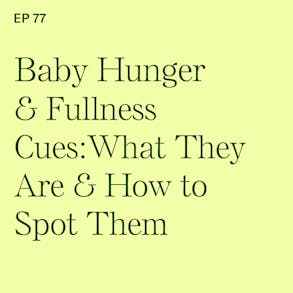

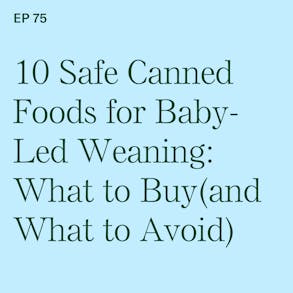
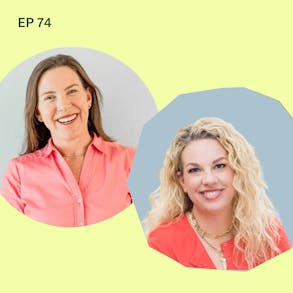
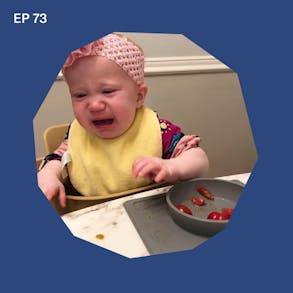
Katie Ferraro (0s):
It's a Baby-Led Weaning day. It's my absolute favorite time of the year. I know everybody has their own day these days, but back in 2021, we designated July 1st to be National Baby-Led Weaning Day. And I did that to honor Gill Rapley, the founding philosopher of Baby-Led Weaning. In the co-author of the original Baby-Led Weaning book, Gill really advocated for waiting until babies are ready to start feeding themselves before we start solid foods. And that's gonna occur for your baby around the six month mark. So July 1st is National Baby-Led Weaning Day because it's six full months into the year, right? If your proverbial baby was born on January 1st, then on July 1st, that baby would be six months of age and very likely ready to start solid foods and showing you those reliable signs of readiness to eat.
Katie Ferraro (49s):
So on Baby-Led Weaning day, we celebrate your baby's ability to feed themselves because babies can eat so many more foods than we give them credit for and they can do it on their own. So if you have a baby who is just starting to get the hang of eating solid foods, or is maybe not gotten the hang of it yet, but you're having some fun doing it, come celebrate Baby-Led Weaning day with me. If you're on Instagram, tag my account @babyledweanteam on your stories. I would love to see your adorable self-feeding baby. We use the #BLWday and I'll reshare all of the adorable babies who are feeding themselves. Keep up the great work offering your baby all those new foods and Happy Baby-Led Weaning Day.
Ezpz (1m 33s):
Heads up. My favorite feeding gear company. EZPZ is celebrating Baby-Led Weaning day with a one day sale. This is huge. They gave me and they're so nice. The biggest discount code I've ever gotten is valid July 1st only, which is Baby-Led Weaning day. Right now you can get 25% off everything, all the feeding gear at ezpzfun.com when you use the code BLWDay2024. So if you're just starting solid foods, check out the EZPZ First Foods set. It's literally what I get all of my friends when they have a new baby or for baby showers. It's exactly what you need to start Baby-Led Weaning. If you only wanna buy one thing, the EZPZ First Foods set is it. Again, that code is BLWDay2024 for 25% off everything at ezpzfun.com. It's valid July 1st, 2024. Only US purchases, only my regular EZPZ code, Katie10 that always works for 10% off, but take advantage of this 25% off with that code. It's good July 1st only. Again, the code is BLWDay2024 for 25% off everything at ezpzfun.com and Happy Baby-Led Weaning day.
Katie Ferraro (2m 44s):
And so back in 2000, the guidance was wait until your baby is three years of age before you offer them peanut protein. And to this day, I'll still have parents that say, oh my gosh, my doctor told me to wait until one to do egg and two to do fish and three to do peanuts. What should I do? I'm like, you should get a new pediatrician because that is very outdated advice. Okay, current guidance and updated guidelines really, really hammers home on this idea of early introduction of these potentially allergenic foods. And a great one to start with is peanut. Hey there. I'm Katie Ferraro, registered dietitian, college nutrition professor and mom of seven specializing in Baby-Led Weaning. Here on the Baby-Led Weaning with Katie Ferraro podcast.
Katie Ferraro (3m 25s):
I help you strip out all of the noise and nonsense about feeding, giving you the confidence and knowledge you need to give your baby a safe start to solid foods using Baby-Led Weaning. How do you know if your baby is allergic to peanuts? The only way to know if your baby is allergic to a food is to feed them that food. So when it comes to peanuts, In, this episode I wanna share three easy ways to safely offer your baby peanut protein, along with tips on how to reintroduce peanut early and often so that you can help lower your baby's risk of peanut allergy down the road. Because all of the recent research and updated guidelines point towards earlier introduction of peanut as a way to help lower the risk of peanut allergy.
Katie Ferraro (4m 10s):
So In, this episode I wanna cover whether or not your baby is at high risk for peanut allergy. We'll talk about When to start offering peanut protein and how often to reintroduce it. And I'll finish it off with three easy ways to make peanuts safe for your baby to eat once they start solid foods. Be sure to hit follow or subscribe wherever you're listening to this podcast so that each week, both of the episodes that I release will show up in your feed. On Monday, I do a mini Baby-Led Weaning training solo episode, and then every Thursday I do a longer in-depth interview with another feeding expert. If you wanna check out my program, Baby-Led Weaning with Katie Ferraro, it has my full 100 First Foods Daily Meal Plan. I show you exactly how to make all the foods safe, which foods to feed, when to do it.
Katie Ferraro (4m 53s):
I took all the guesswork out of it. And that's online at babyledweaning.co/program. I like to start each of these mini training episodes with a Baby-Led Weaning tip of the day. And today's tip is that thick globs of nut butter or intact nuts are a choking hazard. I know we got a lot of peanut butter fans out there personally as a mom of seven small children, six of whom like love peanut butter. I have one daughter who does not like peanut butter and I also do not like peanut butter. And while I normally do not indulge individual food preferences in children, you get what you get is kind of the rule of our house for that one girl. Oh my gosh, I'll make her whatever, say what she wants. 'Cause I also don't love peanut butter, but offering your baby sticky, thick globs of peanut butter, of course it's gonna get lodged in the roof or the sides of their mouth and they don't have the tongue strength or mouth muscles yet to dislodge that.
Katie Ferraro (5m 40s):
So we wanna introduce your baby to peanut protein, but we're not gonna do thick globs of nut butter or intact nuts. But hang tight till the end of this episode, 'cause I'll be explaining the exact steps to modify peanut butter to make it safer for your baby to eat. I wanna tell you guys a quick story about this parenting trend that kind of comes up over time. So like you know, things happen in cycles, right? Something will be really popular for a while, then it'll go away, then it'll come back. The trend that like cycles in and out of the food allergy world is this notion among fairly new parents that, okay, when I introduce my baby to peanut protein, what I'm gonna do is I'm gonna drive my mini van into the parking lot or the driveway of the ER or a medical facility so that if my baby has an allergic reaction to peanuts, then I'll be right there in order to seek medical care.
Katie Ferraro (6m 27s):
And every pediatric allergist will tell you, you do not need to do this. The only babies that may need to introduce peanut under the guidance of a physician's supervision are those babies who are determined to be at high risk for peanut allergy. And so we're gonna talk about what high risk is because I'm pretty certain it's not your baby, okay? The vast majority of babies out there will not be allergic to any foods. In fact, less than 3% of infants will have a food allergy. And peanut allergy is more common. It's actually the most common food allergy in people 18 and under in the United States. But the real risk of your baby having a peanut allergy is actually quite low. And so we don't want you hogging up medical resources or like backing up the ambulance traffic 'cause your minivan's there trying out some thinned out peanut butter.
Katie Ferraro (7m 13s):
So peanut is a potentially anaphylactic food allergy and don don't wanna make light of that. Food allergies are very serious and potentially life-threatening reactions to food proteins. And so allergy to peanuts kind of interesting. It's actually the only food allergy for which a treatment has been approved by the US Food and Drug Administration. We talked a little bit about that elsewhere on this podcast. I'll link to some of the other peanut episodes for you. There are other treatment protocols that are currently being used to help improve tolerance to the peanut protein like peanut oral immunotherapy. These are not necessarily FDA approved at the time of this recording, but when it comes to introduction of peanuts, parents like, I feel so helpless. But you shouldn't because there's something that you can actually do to lower your baby's risk of peanut allergy and that's to introduce peanut protein to them early and often.
Katie Ferraro (8m 0s):
But if you'd had a baby 20 years ago, bless your heart, if you're having another one 20 years later as someone who had had seven kids three and under for a while, we did it all really, really fast. It was like a whirlwind. But like I meet these moms who are, I heard a podcast today with a dad who had 11 kids and one was 18 and he is a 10 week old. It's like, oh my gosh, I cannot even imagine. But like let's say hypothetically you ate 20 years or 20 years ago you had a baby. The guidance about introducing peanut protein, that's when I was studying to be a dietitian, was that we delayed the introduction of peanut till after three years. So based on absolutely no scientific evidence, all of the guidelines, especially that from the American Academy of Pediatrics was withhold peanut until age three. Again, based on absolutely no research.
Katie Ferraro (8m 41s):
It was just like, nah, it feels like a good idea. Then fast forward the learning early about peanut allergy. The LEAP landmark study was published that provided evidence from a very high quality randomized trial that supported this whole paradigm shift for the early introduction of foods. So the LEAP study, again, learning early about peanut allergy leap was the first randomized trial to study early allergen introduction as a preventive strategy. So this like the research results just totally flipped everything we knew on its head because this research found that introduction of peanuts somewhere between four to 11 months of age significantly reduce the risk of developing peanut allergy in high risk infants. So let's talk about that. We're gonna talk about high risk and then I'm gonna talk about that four to 11 month.
Katie Ferraro (9m 24s):
I know some of you heard four, wait, what a minute. What? You're supposed to be doing peanuts at four and five months of age. There's only a very small subset of the population that might benefit from introduction of peanut prior to six months of age. So let's back up first and talk about high risk versus at risk for peanut allergy. Okay? So again, previous guidelines, like back in the day, 20ish years ago, defined high risk as a first degree relative. So at least one parent or sibling that had an allergic condition like atopic dermatitis or food allergy asthma or allergic rhinitis, everything is different. Now, the new addendum guidelines, okay from the National Institutes of Health define at risk very differently now, okay, so a high risk baby, is my baby at risk for peanut allergy?
Katie Ferraro (10m 9s):
Well, all babies are at some risk for having some food allergies, but your baby's considered to be at high risk for developing a peanut allergy if they have severe eczema and or an egg allergy. And that's important 'cause I'm gonna repeat it again 'cause it's probably ruling your baby out if your baby has severe eczema and or an egg allergy. Now, I'm not talking about the run of the mill eczema that I know all your babies have. I mean, I'm looking at an eczema patch on my own arm right now that's not severe eczema for which I'm being treated by a pediatric dermatologist or a pediatric allergist. Okay? Severe eczema, your baby is receiving treatment for that. Or if they already have an established egg allergy, your baby's gonna be at high risk for peanut.
Katie Ferraro (10m 50s):
Allergy at risk defines those who are have infants with mild or moderate eczema. So that's a lot of your babies, but it doesn't matter anymore if you have a younger sibling or a parent. Yes, having first degree relatives puts you at slightly higher risk for that baby to have the food allergy or a food allergy, but it doesn't put your baby in the high risk category. So we know that it's safe for babies to start solid foods, anything besides infant milk around the six month mark? We've done some other episodes on this podcast with some of the world's leading pediatric allergists discussing this idea of, well, what about four and five months of age? If your baby is in that high risk category, again, the very small subset of babies that either has severe eczema and or an egg allergy, then you would wanna talk to your provider.
Katie Ferraro (11m 34s):
Okay? And if it's a pediatrician, not all pediatricians are necessarily up to date on what the most current guidelines and practices are regarding food allergy introduction. I hear from parents all the time who say, oh, my doctor told me not to do egg until after one and fish till two and peanut till three. I'm like, you should get a new pediatrician. 'cause that's more than 20-year-old outdated advice. If your pediatrician doesn't know a lot about food allergies, then can they refer you to a pediatric allergist? Okay? So if your baby's at high risk, then you might need a different course for the introduction of foods like peanuts. But if your baby's not in that high risk category, so the vast majority of those of you listening, then introducing peanut protein around six months of age, once your baby is showing the other reliable signs of readiness to eat, that is ideal, okay?
Katie Ferraro (12m 15s):
Because babies aren't safe to swallow anything except infant milk, breast milk or formula up until six months of age. And so this guidance about maybe starting at somewhere between four and six months of age, what's interesting is that there's no data to support the idea that introducing peanut protein at four or five months of age is any more protective than if you wait until six months of age. Okay? 'Cause you, you've heard those guidelines. The guidance now is introduction somewhere between four and 11 months of age. Researchers do think that the protective window closes around the 11-month mark. We've also covered that 11 month mark window in a totally separate episode with Dr. David Skuas. He's one of the world's leading pediatric allergists. He's out of Nationwide Children's Hospital in Ohio, and he went through this whole idea of like getting those allergenic foods in by 11 months of age, but as a dietitian specializing in infant feeding, my suggestion to parents is if your baby's not in that high risk category for peanut allergy, then wait until six months because there's no data to support the idea of it being quote unquote more protective if you did the peanut at four and five months of age.
Katie Ferraro (13m 23s):
Hey, we're gonna take a quick break, but I'll be right back. So when should we introduce peanut? Back in 2000, I mentioned that the AAP said delay introduction of peanut until age three. In 2008, the AAP partially reversed those 2000 recommendations. In 2013, the Canadian Pediatric Society said don't delay peanut introduction beyond six months of age. And then 2017, the National Institutes of Health updated their guidelines based on leap that said those highest risk infants, again, the ones with severe eczema and or peanut allergy, do it at four to six months of age. And you might need to test for allergies prior to introduction for the at-risk infants around six months of age. So if you have that mild or moderate eczema, do it around the six month mark when you also start solid foods if your baby's low risk, okay, peanut can freely be introduced at home, do it with other solid foods, do it in accordance to your family preferences and your cultural practices.
Katie Ferraro (14m 16s):
But all babies, regardless of their risk level, who demonstrate tolerance, should be eating peanut containing foods regularly in order to maintain their tolerance. So how do we safely introduce peanuts to babies? I wanna share with you three different strategies. The first one being thinned out peanut butter. Okay? If you looked in your house at like what peanut foods you have, depending upon your food culture or if you even like peanut butter, there might be peanut butter there. And peanut butter, as I mentioned in thick globs, can be a choking hazard for early eaters. So we first and foremost always want to avoid chunky peanut butter. Any intact nuts or small pieces of nut can be a choking hazard. What's the opposite of chunky peanut butter? It's smooth peanut butter. Okay? But smooth peanut butter on its own is too sticky. So we want to thin that peanut butter out, and there's a number of ways that you can do this.
Katie Ferraro (14m 60s):
Ideally, we're gonna get that peanut butter so thin that it slides off of your adult stainless steel spoon. That level of thinness is an indicator that it's thin enough that it won't get stuck or lodged on the roof or the sides of your baby's mouth. So how do you thin out your peanut butter? Well, before you even choose the peanut butter, make sure that it has no added sugar and no added salt. Okay? So we want sugar-free salt-free smooth peanut butter, and you can mix it with things like unsweetened apple sauce, breast milk or formula. You can also do whole milk full fat yogurt. Do keep in mind that yogurt and formula contain cow's milk protein. That's a separate potentially allergenic food. So we wanna make sure that your baby has had exposure to cow's milk protein a number of times on its own without reaction before you would do those two foods together. We just don't introduce two new allergenic foods at the same time, right?
Katie Ferraro (15m 41s):
'Cause if you like never had cow's milk and you never had peanut, and you mix some peanut butter up with some yogurt and your baby has a reaction like how would you know? Are they allergic to the cow's milk protein? Or are they allergic to the peanut protein? So make sure you pass cow's milk protein first. Then once you've done that a few times without reaction, it's okay to mix it with the peanut butter, get it nice and thin, and we do what's called the preloaded spoon approach. Okay? And that's where you put the thinned out peanut butter on the spoon. Put the baby spoon in your baby's hand and allow your baby to guide the spoon to their mouth. The spoons that I use for Baby-Led Weaning for this preloaded spoon approach, it's called the Tiny Spoon from EZPZ. It was developed by the EZPZ feeding specialist who's a speech language pathologist.
Katie Ferraro (16m 22s):
The tiny spoon is available 10% off if you use the affiliate discount code, Katie10 at the website, ezpzfun.com. But we can do thin out peanut butter. We just wanna do it off of that preloaded spoon because with Baby-Led Weaning, we don't put anything in the baby's mouth including a spoon. Putting anything in your baby's mouth, including a spoon, can be a choking hazard. Let your baby do it for themselves. And so you can thin out that peanut butter and do it a number of times in my program Baby-Led Weaning with Katie Ferraro, we introduce peanut as the second allergenic food. So we usually do it in week two. We do one allergenic food every week for the first nine weeks. So nine weeks into the program, your baby's knocked out all of those allergenic foods. But I do like to prioritize cow's, milk, protein, peanut, and egg. Those are the most common pediatric food allergies. And I have lots of tips inside of the program with recipes and different videos that show you exactly how to prep these foods safely.
Katie Ferraro (17m 9s):
Again, that's at babyledweaning.co/program. If you want to check that program out along with my 100 First Foods Daily Meal Plan. So you don't even have to think about what food to make your baby when defeated or how to make it safe.The second strategy for safely introducing peanuts is to use peanut flour. Now, don't confuse peanut flour with peanut powder. There's a lot of adult diet foods on the market that are defatted. peanut butter powder like peanut is a legume, right? So it's different than a tree nut. Tree nuts are a separate potentially allergenic food category. You wanna do those early and often as well. But for peanut as a legume, it has fat and it has protein. So some of these products have defatted to quote unquote reduce the calories of peanut butter. Okay? Now, this is an diet culture stuff for adults.
Katie Ferraro (17m 50s):
We don't care about fat or calories for your baby. Fat is actually a good thing for your baby. Still developing brain, a little bit of protein. That's where the potentially allergenic part is the problem with some of the the fatted peanut powder products is that they either contain sugar or they contain artificial sweeteners. So if they took the sugar out, they put artificial sweeteners in, and if they're sugar in it, both of those products, ideally, we don't feed to babies. So there is one brand without artificial sweeteners and without added sugar that you can find. I can't find it at my grocery store, but I can order it from Amazon. So you can do peanut powder if you want to, but I just prefer peanut flour. It's actually quite easy. You can use the peanut flour in place of some of the all-purpose flour in your recipes.
Katie Ferraro (18m 31s):
If you're baking things like Baby-Led Weaning pancakes for your baby or mini muffins, I have a lot of recipes utilizing peanut flour inside of that program. I like peanut flour because it's certainly more affordable than some of the peanut powders. I like it as an adult. I use it for pancakes because it makes me feel fuller for longer. Of course, that's not really a concern for your baby, but that peanut flour is something that you probably gonna be able to utilize in a couple of other recipes in your household as well. You can make really easy little pancakes for your baby. They do better if they're made with egg. But keep in mind that egg is also a separate potentially allergenic food. So I don't love mixing multiple allergenic foods together, although you certainly can. If your baby's already passed one of them and you've done it a number of times without reaction, feel free to include it to a second one.
Katie Ferraro (19m 18s):
Hey, we're gonna take a quick break, but I'll be right back. Now. The third way that I introduce peanut safely to babies is I like to use peanut puffs. So there's a brand called Puffworks. They make a product called Puffworks, baby peanut Puffs. And I love these puffs because they're the softest puffs on the market. So they dissolve really easily in your baby's mouth. You can start these even before your baby has teeth. They kind of look like a brown Cheeto. They taste like stale peanut butter. Again, don don't love peanuts, but I like this product because the Puffworks. Baby peanut puffs are a no stress, low mess way to safely introduce peanut to the baby. There's no added sugar in them. A lot of the other brands of peanut puffs out there do have added sugar.
Katie Ferraro (19m 59s):
And again, it's best to avoid added sugar for your baby. The AAP recommends no added sugar up until age two. So when I look at a package product, if I'm considering offering it to my baby, I like it to have zero grams of added sugar. The Puffworks, baby puffs have that. They're also very low in sodium. They just have a smidge of sodium that's for preservative. Some of the other national brands that you'll see have a lot of added sodium 'cause they're marketed to adults. So the Puffworks, baby peanut puffs are ideal for your baby. You can get 15% off all of the products at puffworks.com if you use the code BLWpod at Puffworks also makes a baby almond puff. And now they have a combination case where you can get half baby peanut and then half baby almond or they're, that's how we do train.
Katie Ferraro (20m 41s):
Now with Almond one, they're packaged in separate individual packages, so you're not like cross contaminating. So you do the peanut one first a number of times to make sure the baby doesn't have peanut allergy. And then later you can do the tree nut one, the almond one, the Puff Works baby. Almond puff does have peanut in it. So you wanna make sure you've already done peanut on its own a number of times without reaction before you do the almond one. But you can also get 15% off that combination case at puffworks.com with that code BLWpod, and they're at puffworks.com. So I'll leave you with a quick win if you haven't done peanut yet, do it this Friday. Okay, following my five step feeding framework, we introduce five new foods to babies every week. A new fruit on Monday, a new vegetable on Tuesday, a starchy food on Wednesday, a protein on Thursday, and then an allergenic food on Friday.
Katie Ferraro (21m 27s):
And we do that allergenic food two times on Friday, two times on Saturday, two times on Sunday with no other new foods across the weekend. And you do continue to reintroduce familiar foods from previous days across the weekend. But when you're done with that weekend, you're gonna have done that allergenic food six, maybe seven times. And if your baby didn't have an allergic reaction, you can rest assured, ah, I knocked another one of those top nine allergenic foods off of the list. The top nine allergenic foods are the nine foods that account for about 90% of food allergy in North America. If you haven't done peanut yet, put it on your calendar for this Friday and then continue to offer peanut frequently, right? Because it's not just a one and done. We need to offer these allergenic foods early and often. And parents will say, well, you know, how much peanut protein is that that I should do?
Katie Ferraro (22m 12s):
And how often? And I want you to know that there's no hard and fast evidence to say exactly how much of the peanut protein your baby needs to have. Okay? We know that they need to get some of it into their system. And certainly early on when you start solid foods, they're not gonna eat a lot of the pancake or a lot of the thinned out peanut butter off of the preloaded spoon. They will eat a lot of those Puffworks, baby peanut puffs that sometimes the parents that are like, you didn't tell me these things are a habit for me. The baby absolutely loves them. There's certainly other foods that you're gonna continue to introduce. But if you have those puffs, you can take 'em with you on the road or when you're out and about and continue to reintroduce your baby to that peanut protein. So make sure you do it early and often.
Katie Ferraro (22m 53s):
I will put all of the resources I mentioned in today's episode on the show notes for this episode. You can find that@blwpodcast.com. The code again for Puff Works baby. If you wanna check out those peanut puffs as well as their almond puffs, which is a way to do Tree nut, that's BLWpod at puffworks.com and my program Baby-Led Weaning with Katie. Ferraro has all of the recipes and all of the videos that show you exactly which foods to offer, how to make them safe for your baby, and when to feed them so that you don't have to worry about what to feed your baby. Next, you can check that out at babyledweaning.co. A special thank you to our partners at AirWave Media. If you like podcasts that feature food and science in using your brain, check out some of the podcasts from AirWave.
Katie Ferraro (23m 44s):
We're online at blwpodcast.com. Thanks so much for listening, and I'll see you next time.
What If World (23m 48s):
Parents, did you know there are podcasts for kids? I'm here to tell you about mine. What if worlds, I answer What if questions with wild and funny stories? Tell them how. What if world has a huge cast of magical characters? Okay. And how each story has a positive message. Yeah. Yeah. What if world is great for bedtime car rides or whenever kids just need to unplug? You can find what if World on Apple Podcasts or wherever you listen.
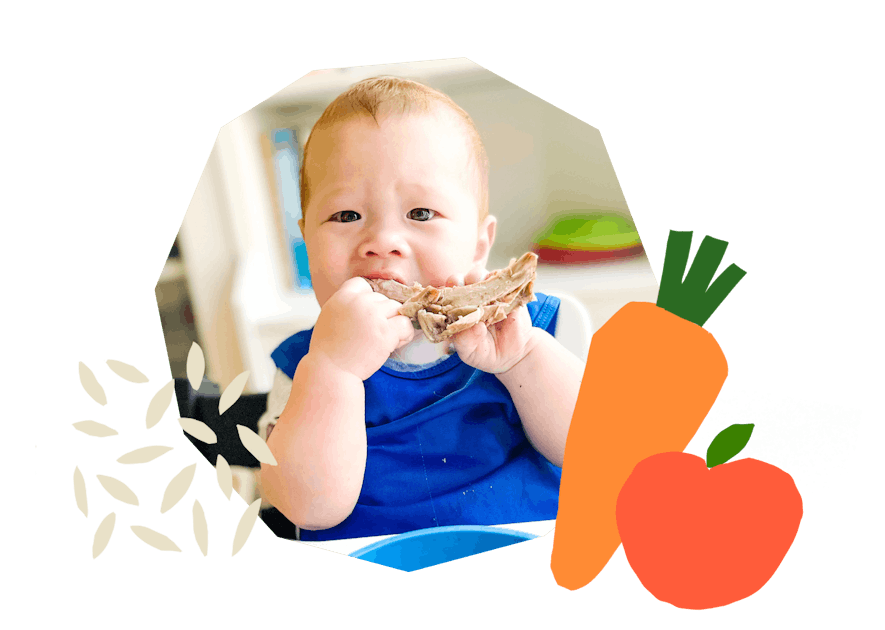
The Program Baby-Led Weaning with Katie Ferraro
A step-by-step digital program for starting solid foods safely and navigating the original 100 FIRST FOODS™ meal plan with baby-led weaning.
 EXPERT-LED, PROVEN APPROACH TO EATING REAL FOOD
EXPERT-LED, PROVEN APPROACH TO EATING REAL FOOD CONCISE VIDEO TRAININGS TO MASTER BABY-LED WEANING
CONCISE VIDEO TRAININGS TO MASTER BABY-LED WEANING 100 FIRST FOODS DAILY MEAL PLAN WITH FOOD PREP VIDEOS
100 FIRST FOODS DAILY MEAL PLAN WITH FOOD PREP VIDEOS
Baby-Led Weaning for Beginners Free Workshop
Is your baby ready to start solid foods, but you’re not sure where to start? Get ready to give your baby a solid foundation to a lifetime of loving real food…even if you’re feeling overwhelmed or confused about this next stage of infant feeding.
Get baby-led weaning recipes and tips delivered to your email inbox.

